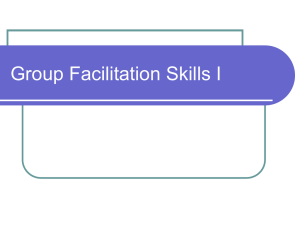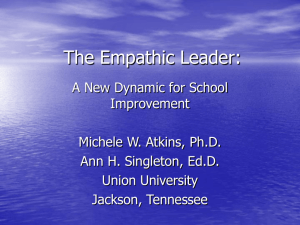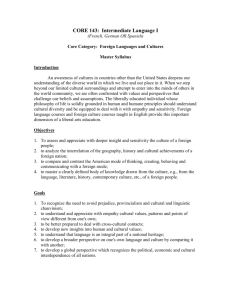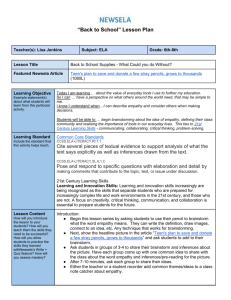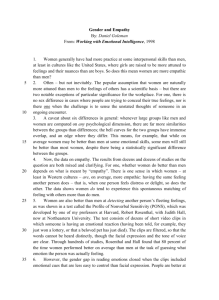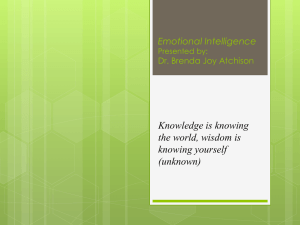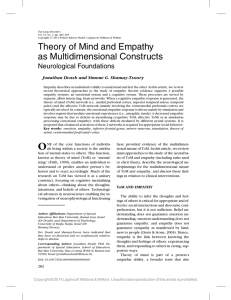Is Empathy (Radically) Embodied? Mark Miller Department of
advertisement
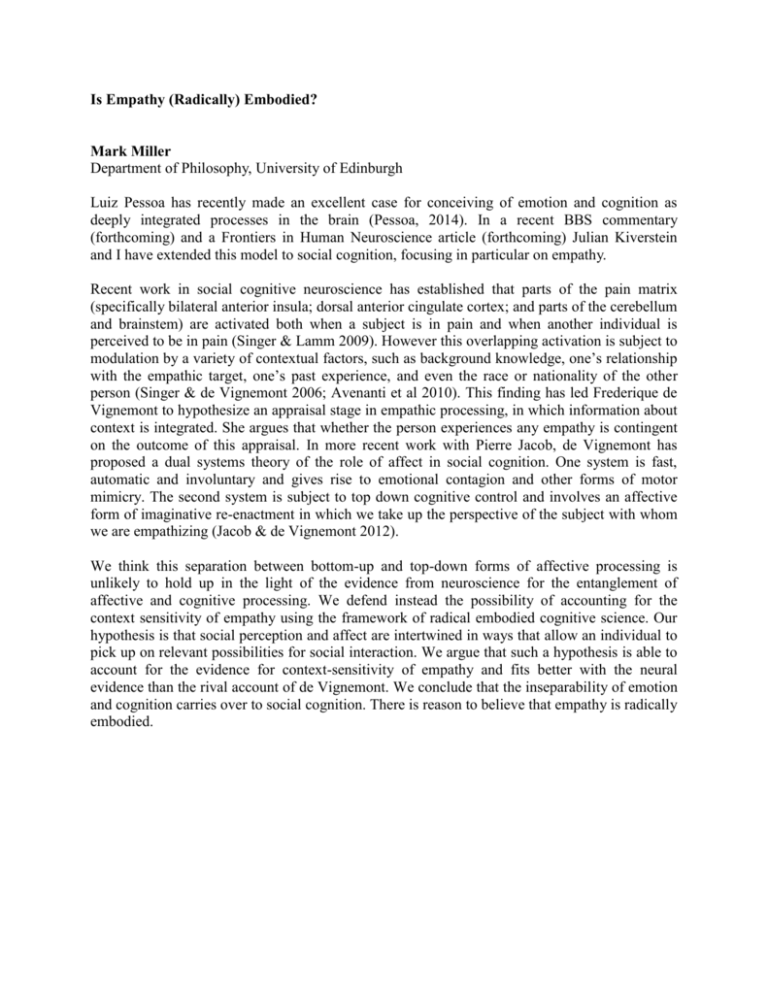
Is Empathy (Radically) Embodied? Mark Miller Department of Philosophy, University of Edinburgh Luiz Pessoa has recently made an excellent case for conceiving of emotion and cognition as deeply integrated processes in the brain (Pessoa, 2014). In a recent BBS commentary (forthcoming) and a Frontiers in Human Neuroscience article (forthcoming) Julian Kiverstein and I have extended this model to social cognition, focusing in particular on empathy. Recent work in social cognitive neuroscience has established that parts of the pain matrix (specifically bilateral anterior insula; dorsal anterior cingulate cortex; and parts of the cerebellum and brainstem) are activated both when a subject is in pain and when another individual is perceived to be in pain (Singer & Lamm 2009). However this overlapping activation is subject to modulation by a variety of contextual factors, such as background knowledge, one’s relationship with the empathic target, one’s past experience, and even the race or nationality of the other person (Singer & de Vignemont 2006; Avenanti et al 2010). This finding has led Frederique de Vignemont to hypothesize an appraisal stage in empathic processing, in which information about context is integrated. She argues that whether the person experiences any empathy is contingent on the outcome of this appraisal. In more recent work with Pierre Jacob, de Vignemont has proposed a dual systems theory of the role of affect in social cognition. One system is fast, automatic and involuntary and gives rise to emotional contagion and other forms of motor mimicry. The second system is subject to top down cognitive control and involves an affective form of imaginative re-enactment in which we take up the perspective of the subject with whom we are empathizing (Jacob & de Vignemont 2012). We think this separation between bottom-up and top-down forms of affective processing is unlikely to hold up in the light of the evidence from neuroscience for the entanglement of affective and cognitive processing. We defend instead the possibility of accounting for the context sensitivity of empathy using the framework of radical embodied cognitive science. Our hypothesis is that social perception and affect are intertwined in ways that allow an individual to pick up on relevant possibilities for social interaction. We argue that such a hypothesis is able to account for the evidence for context-sensitivity of empathy and fits better with the neural evidence than the rival account of de Vignemont. We conclude that the inseparability of emotion and cognition carries over to social cognition. There is reason to believe that empathy is radically embodied. References Avenanti, A., Sirigu, A. & Aglioti, S.M. 2010. Racial bias reduces empathic sensorimotor resonance with other-race pain. Current Biology 20, pp. 1018-1022. De Vignemont, F. & Jacob, P. 2012. What is it like to feel another’s pain? Philosophy of Science 79.2, pp.295-316. De Vignemont, F. & Singer, T. 2006. The empathic brain: how, when and why? Trends in Cognitive Science 10.10, pp.435-441. Kiverstein, J. & Miller, M. (forthcoming). Empathy, and the cognitive-emotional brain. Behavioral and Brain Sciences. Miller, M. & Kiverstein, J. (forthcoming). Is social cognition (radically) embodied? Frontiers in Human Neuroscience. Pessoa, L. (2014). The cognitive-emotional brain: from interactions to integrration. MIT press. Singer, T. & Lamm, C. 2009. The social neuroscience of empathy. Annals of the New York Academy of Sciences 1156, pp.81-96. Outline for the Talk: - Intro: I have chosen not to make a powerpoint presentation. At a conference about self and other, and about the perhaps paradigmatically huan capacity to empathize, I felt it mildly absurd that I would create a situation in which instead of grocking you you spend your time grocking the screen - a keen way to break down what empathic communication we may hope to achieve. Do you know the sci-fi term 'grok'? Robert A. Heinlein (?) invented the word to express how martians communicate - to understand something so thoroughaly that the observe becomes part of the observed (bookend with grok).. - empathy was classically believed to be automatic (Einflungen) - empathy has been found to be contextually sensitive - appraisals participate - this has lead to a mystery - how do these levels relate? - Early vs. Late / DeV and J try and side step this with cognitive vs. affective empathy - this is only a mystery becasue outdated models of emotion are being relied upon - emotion, perception, cognition are bound at neural level and psychological level. - empathy is the result of emotional-appraisals grrowing over time - contrast this with other contemporary theories of empathy as embodied: - De Vignemont and Goldman - B-representations - Prinz and embodied emtoions ? Predictive Mind and empathy is my future interest. - We Grok - my understanding of you is constituted by shared emotional reactions. I dont see you, decide something about you, and assign some state to you - I feel-think-see you in a comprehensive way.




